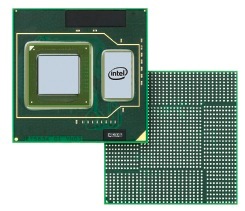Intel to add parallel processing IP into future Atoms
Mar 18, 2011 — by LinuxDevices Staff — from the LinuxDevices Archive — 9 viewsIntel has acquired Silicon Hive, a company that has specialized in developing programmable parallel processor technology for SoCs (systems on chip). The Dutch firm's intellectual property will be used to deliver “more differentiated Atom-processor based SoCs,” the chip giant says.
The Silicon Hive acquisition, involving an undisclosed amount of money, was first announced by Intel at February's Mobile World Congress, where it obviously got lost in the shuffle. It was therefore announced again yesterday by the global venture capital firm New Venture Partners, apparently proud of having unloaded one of the companies in its portfolio.
Silicon Hive was spun out of a Philips technology incubator in April 2007, at which time it raised $10 million in funding from New Venture Partners, Philips, and TVM Capital. In 2009, the Eindhoven, Netherlands-based company got another $7 million round of funding — led by Intel Capital, the chip giant's private equity arm.
Then, in Feb. 2010, Silicon Hive announced a technology collaboration with Intel, through which it would "apply its parallel processing technology across mobile and embedded segments based on the Intel Atom Processor roadmap." A month later, the company announced HiveLogic — a "configurable parallel processing platform enabling … unprecedented silicon area utilization and power consumption efficiency" — and said LSI Logic would be an initial licensee.
Presumably, Intel has not yet had time to incorporate any of Silicon Hive's intellectual property (IP) into its Atom processors. The chipmaker's Feb. announcement said the "Silicon Hive capabilities will aid in the delivery of more differentiated Atom-processor based SoCs as multimedia and imaging grow in importance across the mobile smart device segments," and New Venture's release yesterday merely incorporated the same language.
 But, of course, Intel has already shown its eagerness to expand the burgeoning Atom family via add-on IP. Last November, it announced six Atom E6x5C processors (right), which include on-chip Altera FPGAs (field programmable gate arrays).
But, of course, Intel has already shown its eagerness to expand the burgeoning Atom family via add-on IP. Last November, it announced six Atom E6x5C processors (right), which include on-chip Altera FPGAs (field programmable gate arrays).
Atom CPUs have been criticized for their relatively feeble graphics (currently based on Imagination Technologies IP). Silicon Hive's parallel processing IP could be used to help Intel compete with vendors such as Nvidia — which already uses parallel processing in its GPUs (graphics processing units) and is now promoting it more generally for high-performance computing.
Silicon Hive architecture
(Click to enlarge)
According to Silicon Hive, its architecture (above) solves I/O bottlenecks "by using dozens of small parallel register files and a multitude of local data memories, rather than large unified register files and centrally shared memories that will easily become performance bottlenecks." The company claims that processors based on its IP "typically process 4 to 8 times more instructions in parallel than conventional VILV [very long instruction word] processors and 10 to 30 times more parallel SIMD [single instruction multiple data] operations."
Silicon Hive's website lists its different IP offerings as follows:
- HiveGo CSS3000 series — licensable camera IP that supports camera sensors ranging from five to 16 megapixels, and performance "from 15 to 270 megapixels per second and beyond"
- HiveGO VSS3000 series — video system solution IP that supports 1080p performance, embedding standard and proprietary codecs in software so they can be upgraded "pre- and post-silicon and in the field"
- HiveFlex CSP family — RF, MIMO, and OFDM processors for cellular and data terminals that provide very high sampling/data rates plus "industry-leading performance and efficiency"
- HiveFlex ISP series — IP optimized for image signal processing, again offering performance from 15 to 270 megapixels per second
- HiveFlex VSP2500 series — video signal processing IP that includes image stabilization, video encoding, video decoding, frame-rate conversion, and spatial scaling; works at full HD (1080 30p) and higher (1080 120p)
Development tools, meanwhile are said to include the HiveLogic product mentioned earlier in this story, plus the HiveCC software development kit. The latter is designed to take a user's multi-processor system description and compile it into system simulation models and system-level drivers, according to the company.
Jonathan Angel can be followed at www.twitter.com/gadgetsense.
This article was originally published on LinuxDevices.com and has been donated to the open source community by QuinStreet Inc. Please visit LinuxToday.com for up-to-date news and articles about Linux and open source.